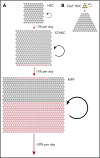Differentiation-based model of hematopoietic stem cell functions and lineage pathways
- PMID: 30042097
- PMCID: PMC6307983
- DOI: 10.1182/blood-2018-03-791517
Differentiation-based model of hematopoietic stem cell functions and lineage pathways
Abstract
Advances in genetic labeling and barcoding of hematopoietic stem cells (HSCs) in situ now allow direct measurements of physiological HSC output, both quantitatively and qualitatively. Turning on a heritable label in HSCs and measuring the kinetics of label emergence in downstream compartments reveal rates of differentiation and self-renewal of HSCs and progenitor cells, whereas endogenous HSC barcoding probes physiological precursor-product relationships. Labels have been inserted at different stages of the hematopoietic differentiation hierarchy. Recent genetic and functional evidence suggests a phenotype (Tie2+ ) for tip HSCs. Fate mapping shows that many tip HSCs regularly feed into downstream stages, with individual cells contributing infrequently. Stem and progenitor cells downstream of tip HSCs serve as a major, nearly self-renewing source of day-to-day hematopoiesis, rendering the blood and immune system HSC-independent for extended periods of time. HSCs realize multilineage output, yet, fates restricted to several lineages or even a single lineage have also been observed. Single HSCs within a clone in the bone marrow that develop from a fetal HSC precursor have been observed to express clone-specific fates. Thus, the new tools probing HSC differentiation in situ are progressing beyond assays for HSC activity based on proliferation measurements and fates of transplanted stem cells, and the data challenge lineage interpretations of single-cell gene expression snapshots. Linking in vivo fate analyses to gene expression and other molecular determinants of cell fate will aid in unraveling the mechanisms of lineage commitment and the architecture of physiological hematopoiesis.
© 2018 by The American Society of Hematology.
Conflict of interest statement
Conflict-of-interest disclosure: The authors declare no competing financial interests.
Figures


References
-
- Yamamoto R, Morita Y, Ooehara J, et al. . Clonal analysis unveils self-renewing lineage-restricted progenitors generated directly from hematopoietic stem cells. Cell. 2013;154(5):1112-1126. - PubMed
-
- Perié L, Duffy KR, Kok L, de Boer RJ, Schumacher TN. The branching point in erythro-myeloid differentiation. Cell. 2015;163(7):1655-1662. - PubMed
-
- Hoppe PS, Schwarzfischer M, Loeffler D, et al. . Early myeloid lineage choice is not initiated by random PU.1 to GATA1 protein ratios. Nature. 2016;535(7611):299-302. - PubMed
-
- Carrelha J, Meng Y, Kettyle LM, et al. . Hierarchically related lineage-restricted fates of multipotent haematopoietic stem cells. Nature. 2018;554(7690):106-111. - PubMed
Publication types
MeSH terms
LinkOut - more resources
Full Text Sources
Other Literature Sources
Medical
Miscellaneous

